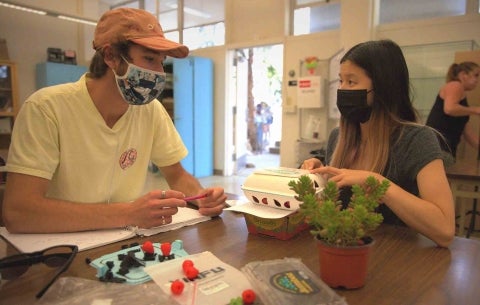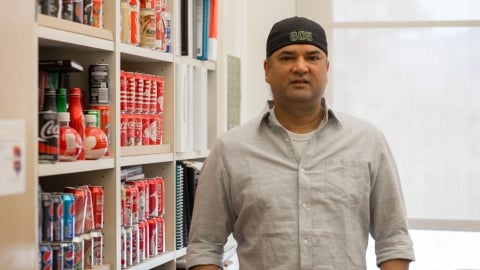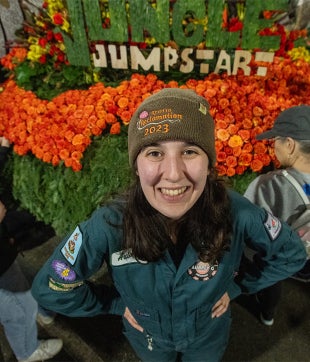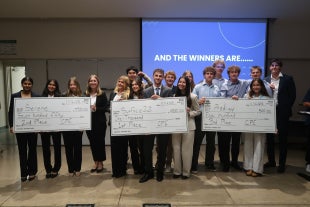Cal Poly Professors Say State Law Mandating Plastic Packaging Be Recyclable Could Promote Positive Sustainable Innovation — But Plastic Isn’t Always Bad, or the Most Damaging
Contact: Pat Pemberton
805-235-0555; ppembert@calpoly.edu
SAN LUIS OBISPO, Calif. — Even before California passed a ground-breaking law requiring all plastics be recyclable or compostable by 2032, Cal Poly students were exploring more sustainable packaging alternatives, professors said.

“We need professionals who understand the profound implications of their design decisions,” said Javier de la Fuente, who chairs the Industrial Technology and Packaging area in the Orfalea College of Business. “I repeat this to my students all the time.”
And, he added, more legislation will be needed to make a difference.
“The regulations of one state are clearly insufficient to solve challenges that do not recognize borders,” de la Fuente said. “More policies will be needed to have a real effect.”
When Gov. Gavin Newsom signed SB 54, Solid Waste: Reporting, Packaging and Plastic Food Service Ware, into effect June 30, his office noted that this legislation became law after the U.S. Supreme Court limited the federal government’s ability to address pollution and climate change. The law vows to cut plastic packaging by 25 percent in 10 years and requires 65 percent of all single-use packaging to be recycled in the same timeframe.
Since the 1950s, the use of plastic has increased exponentially — particularly in the past 20 years — according to “The Plastic Economy,” a 2021 research paper co-authored by Cal Poly economics professor Jacqueline Doremus. According to that research, plastic production is expected to reach four times the current levels in 2050.
In many ways, plastic has improved modern life. It protects medical devices, allow cars to be lighter and more fuel efficient, and keeps food fresh.
Professor Jay Singh

“I’m not saying plastic is perfect,” said Jay Singh, a professor and program director of Cal Poly’s Packaging Department. “But if we want to have fresh asparagus from Peru available to us in California any time of the year, you can’t have that lifestyle without plastic being involved.”
At the same time, one of plastic’s best qualities — its durability — poses multiple threats to the environment. Beyond disturbing images of marine life trapped in nets or plastic rings, solid plastic waste creates micro particles of plastic, or microplastics the size of a sesame seed or smaller, that have been found in the water we drink, air we breathe and food we eat, de la Fuente said.
“Microplastics have been found in humans’ bloodstream, tissues, and organs,” de la Fuente said. “A recent study found that viruses can survive longer in the environment by attaching to microplastics in fresh water.”

We don’t know the full danger microplastics can pose to humans, he added, but cancer and damage to DNA molecules are possibilities. “These particles may be toxic to humans,” he said.
Students in Cal Poly’s program — which is the only one of its kind in a U.S. business school — are encouraged to explore sustainable packaging — “from understanding protection needed and consequences of choosing different materials and manufacturing processes, to calculating carbon footprint using life cycle assessment software,” de la Fuente noted.
Last winter, he added, students in a fiber-based packaging class worked with the Paperboard Packaging Alliance to develop packaging systems for substituting single-use plastic.
But recycling is complicated. Only 5 percent of plastic waste generated in the U.S. is recycled, while 85 percent ends up in landfills.
“It’s rugged, and it’s durable,” Singh said. “On the other hand, it doesn’t break down. It doesn’t degrade.”
Not all plastics can be recycled, and systems aren’t currently in place to recycle much, Singh said.
However, he added, consumers have to always consider the alternative — which offers even more complications. During the pandemic, he said, more people ordered products online, resulting in more packaging.
“A lot of it recently has been arriving in bags,” he said, which protects the products yet adds plastic waste. “But if I put it in a box, that’s going to take up more volume, and it’s heavier. You’re using more resources, not only in the material, but also in the shipping. You need more fuel to move them on trucks, you need more volume and space in storage or a delivery van.”
At the same time, he said, regulations can force consumers to think differently and industry to innovate.
“Just because we love to drink out of a straw, that doesn’t mean it’s the only way,” he said, noting companies like Starbucks have begun using strawless lids.
While “conscious shoppers” — people seeking to buy more sustainable products — had emerged pre-pandemic, the desire for social distancing became a bigger priority.
“It was more related to hygiene and safety features,” Singh said. “They wanted individually wrapped products to make sure they were safe.”
Now he expects a shift back to conscious shopping. But the pandemic increase in e-commerce marked a shift in consumer behavior that’s likely to remain.
Companies have made conscious decisions as well. But their behavior is shaped by costs, which lead to continued plastic usage.
“Plastics are often chosen because they make immediate economic sense, not because of their superior barrier properties,” de la Fuente said. “Regulations can help with both challenges caused by providing incentives for better recycling and better design and decision-making.”


